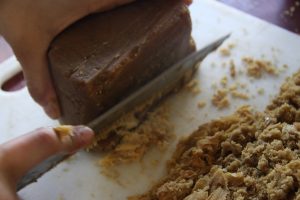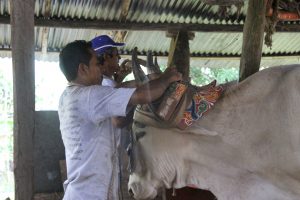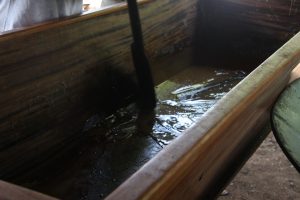Written by: Melissa Quoinez
I have always thought that I was pretty in touch with my food since I like to read the nutrition label on the back of the packaging, but I was wrong. During our trip in Costa Rica, I had the privilege to see sugar cane, or kaña, be processed into a block of sugar and it changed my perspective about the types of food I eat and how they are actually made.
As we were traveling to Mastatal, the second destination during our trip, we decided to stop at a trapiche or sugar mill/press. I had never heard of a trapiche and I was curious about its functions. It was a simple structure with a roof and support columns over the grinding mill and the cooking and cooling troughs and tables but the people and t heir liveliness was what made it so much fun. The trapiche is a family owned business. Paco owns the trapiche with his brother Juan and their 5 other brothers and sisters. As I was talking to Paco, he was telling me that the trapiche has been in his family for two generations and he would like to keep it that way in the future. The first thing I take notice of were the two large oxen. I had never seen an ox so close. I was a little afraid but I soon got over it as I began to take pictures of them. They were connected to the trapiche grinding mechanish by a “yugo”, which is a wooden device that sits on the backs of the oxen. This yugo was connected to a huge wood beam made out of buena maste wood, that was made by Paco’s grandfather. This beam, with the help of the oxen, is what rotates the trapiche and starts the process of making dulce.
heir liveliness was what made it so much fun. The trapiche is a family owned business. Paco owns the trapiche with his brother Juan and their 5 other brothers and sisters. As I was talking to Paco, he was telling me that the trapiche has been in his family for two generations and he would like to keep it that way in the future. The first thing I take notice of were the two large oxen. I had never seen an ox so close. I was a little afraid but I soon got over it as I began to take pictures of them. They were connected to the trapiche grinding mechanish by a “yugo”, which is a wooden device that sits on the backs of the oxen. This yugo was connected to a huge wood beam made out of buena maste wood, that was made by Paco’s grandfather. This beam, with the help of the oxen, is what rotates the trapiche and starts the process of making dulce.
As the oxen are going around the trapiche, they put the kaña (sugar cane) into the metal trapiche that squeezes t he kana juice and deposits it into a metal container. From here they pour the kaña juice into the paila, which is big metal pan, that is resting on kiln-like stove that is fueled by the husks of the dried up kana plants.
he kana juice and deposits it into a metal container. From here they pour the kaña juice into the paila, which is big metal pan, that is resting on kiln-like stove that is fueled by the husks of the dried up kana plants.
Once they put in as much kaña juice as they want, they put it in a concoction made out of a plant named mozote that lets out a sticky substance that helps clean the kaña. They stir it very well and once the mozote is done cleaning the juice, it floats to the top and they strain the dirt off the juice. They cook this cleaned kaña juice for about four hours until it starts to bubble and caramelize. Once the kaña juice is cooked, they hand pour it into a wooden trough where Paco starts to move the caramelized kaña with a wooden oar. Once the caramelized kaña is thick, they start to put it into the tandas or molds. Each tanta has about 32 molds which is a lot. They wait and once the molds are cool enough, they take the dulce out of the molds and start to wrap them with the kaña leaves and then you finally have dulce. They repeated this process about 3 to 4 times depending on the demand.
My favorite part was the people who were in the trapiche. It was so lively in there with the kids playing with the oxen and people talking to people randomly. It was so awesome not only seeing but feeling the concept of community in Costa Rica and I fell in love with the carefree attitude that they portrayed. I really do hope that I go back and have some dulce one more time.

